

Apps as Assistive Technology (AT) – Maine CITE. To aid consumers and professionals who may be interested in knowing more about various mobile devices (including smart watches) and the assorted “apps” than can be used as assistive technology, we have assembled this resource.
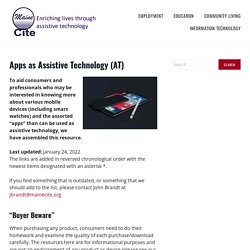
Last updated: April 5, 2021 The links are added in reversed chronological order with the newest items designated with an asterisk *. If you find something that is outdated, or something that we should add to the list, please contact John Brandt at jbrandt@mainecite.org. 25 Best Education Sites & Apps For 2020. It's the time of year again for my favorite annual sites and apps.
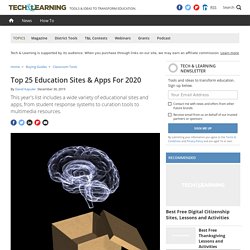
This year's list includes a wide variety of educational tools, from student response systems to curation tools to multimedia resources. Many are new and some are free. As always, tools listed in previous end-of-year posts are not eligible for this year's list. EdTech Blogs - Kathy Schrock's Guide to Everything. Teaching Resources For Students And Teachers. AT Coalition. Unlike existing resources, which are mostly geared for AT professionals, this resource is user friendly, even for people who don't know anything about AT at all.
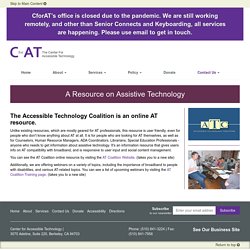
It is for people who are looking for AT themselves, as well as for Counselors, Human Resource Managers, ADA Coordinators, Librarians, Special Education Professionals - anyone who needs to get information about assistive technology. It's an information resource that gives users info on AT compatibility with broadband, and is responsive to user input and social content management. You can see the AT Coalition online resource by visiting the AT Coalition Website. (takes you to a new site) Additionally, we are offering webinars on a variety of topics, including the importance of broadband to people with disabilities, and various AT-related topics. Professional Learning Networks - ISTE Connect. Digital Citizenship. Digital Citizenship Consulting - Education, Technology Support. 9 Resources for Teaching Digital Citizenship. 10 Tips To Keep Your Kids Safe On Social Media - Pine Grove Day Camp.
There’s no doubt that we live in a digital world and as our children become more and more tech savvy in this digital age, it’s important that parents maintain a vigilant sense of security when it comes to our children’s online presence.
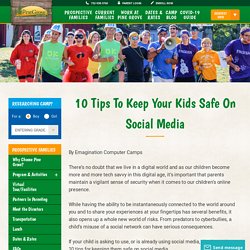
While having the ability to be instantaneously connected to the world around you and to share your experiences at your fingertips has several benefits, it also opens up a whole new world of risks. From predators to cyberbullies, a child’s misuse of a social network can have serious consequences. How Schools Can Manage Official Social Media Accounts and Protect Student Privacy. With many schools boasting large and active communities, it’s unsurprising that social media has become a popular tool in education.

Social media platforms offer an engaging way to share information and connect students, parents, and teachers. A Facebook page or Twitter account makes it easy to inform everyone that school has been closed because of snow, remind parents of important upcoming events, or simply celebrate the latest team win. But it doesn’t end there. Studies suggest that social media use in schools has some real educational benefits. “Thanks to these platforms, instructors, and students are now able to communicate with each other within or between classes,” states one research paper. Top 10 Internet Safety Rules. A 19-year-old running for public office in New Hampshire found out about the importance of following Internet safety rules the hard way.
As Seacoast Online reports, his opponents found images in his social media posts that were sexually suggestive and referenced past drug use. Just like that, his political career crashed and burned upon takeoff. But, unfortunately, he isn't the only one, as careless Internet habits have left others exposed to scams, identity theft and physical harm at the hands of people they met online.
With more users accessing the Internet through mobile devices, these risks are changing and growing quickly. Even though apps loom larger in most people's daily online interactions than traditional websites do, that does not mean that the basic Internet safety rules have changed. Kids Online. The Growing Importance of Technology in Education.
How Technology is Already Breaking Down Barriers in Education The cost of education has significantly reduced, with options like online degrees and by eliminating the need to buy physical textbooks.
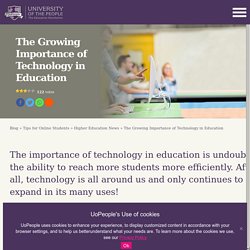
By accessing scholarly articles from your university’s database, for example, you can easily choose to continue your studies from another country or without leaving your home. The State of Technology in Education Report 2020/21 - Promethean. With 5 years’ worth of data and over 8,000 educators surveyed since 2016, we’ve seen what’s remained constant and what's changed in education in over half a decade.
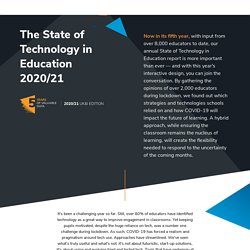
Unsurprisingly, the number of educators that expect remote learning tools and online content to grow has skyrocketed this year. After no change in 4 years, this has jumped 35% in the past 12 months. 6 Pros & Cons Of Technology In The Classroom In 2021. Technology in education is the biggest change in teaching we will ever see.

For years, policy makers, teachers, parents and students alike have been weighing the potential benefits of technology in education against its risks and consequences. Prior to March 2020, some would say that technology allowed you to experiment in pedagogy, democratize the classroom and reach Generation Z students. 8 Technologies That Will Shape Future Classrooms.
What does the future of learning hold? What will classrooms of the future be like? Emerging technologies such as cloud computing, augmented reality (AR) and 3D printing are paving the way for the future of education in ways we may have yet to see. 10 Reasons Today’s Students NEED Technology in the Classroom. Technology is everywhere--entwined in almost every part of our culture.
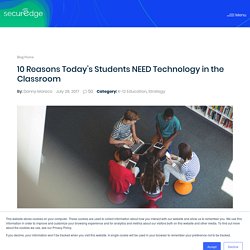
It affects how we live, work, play, and most importantly learn. With mobile and other wireless devices like the IoT becoming an increasing requirement across every industry today, it only makes sense that our schools are also effectively deploying mobile technology in the classroom. However, for many schools, implementing the latest technology is a difficult strategy to navigate. There are two main reasons for this: Educational technology, edtech, classroom technology. As pandemic makes tech indispensable, its role still varies. Dive Brief: Though teachers may be eager and even required to use technology with students, especially as it has become a necessity for remote learning during the coronavirus pandemic, knowing how to effectively weave these tools into lessons to enhance digital learning may pose a challenge, Edutopia reports.One method to consider is to look at the SAMR model, which may help educators build the best plan for their needs by examining four areas: substitution, augmentation, modification and redefinition.Substitution (replacing one thing, like a physical worksheet, with a digital version) and augmentation (expanding that step by adding, for example, a hyperlink to an online video) are at the base level.

Dive Insight: Every step does not need to be addressed for the SAMR model to work. Integrating Technology with Bloom’s Taxonomy - Teach Online. Creating authentic learning experiences for students is an essential element in online course delivery. Through recent discussion instructors have inquired “How do we provide meaningful learning experiences for students using tools that are intrinsically motivating?” 2 Questions as such imply the need to provide instructors with “. . . innovative ways of integrating technology that encourage higher-order thinking skills.” 2 Research indicates that “Today’s students, regardless of demographics, have shown an interest in digital opportunities to learn, and the range of Web 2.0 tools that make collaboration, innovation, and individual exploration possible is incredible.” 2 Practitioners within the field of education have thought of unique ways to connect digital tools with the framework of Bloom’s Revised Taxonomy, which has led to the emergence of a Digital Bloom’s Taxonomy.
How creative use of technology may have helped save schooling during the pandemic. It is estimated around half the world’s students’ schools remain shut down. All told, this has been a potentially damaging disruption to the education of a generation. But one of the few positive outcomes from this experience is an opportunity to rethink how digital technologies can be used to support teaching and learning in schools. Our collective experiences of remote schooling offer a fleeting opportunity for schools to think more imaginatively about what “digital education” might look like in the future. ISTE Blog. The rise of online learning during the COVID-19 pandemic. The COVID-19 has resulted in schools shut all across the world. Globally, over 1.2 billion children are out of the classroom. As a result, education has changed dramatically, with the distinctive rise of e-learning, whereby teaching is undertaken remotely and on digital platforms.
Research suggests that online learning has been shown to increase retention of information, and take less time, meaning the changes coronavirus have caused might be here to stay. While countries are at different points in their COVID-19 infection rates, worldwide there are currently more than 1.2 billion children in 186 countries affected by school closures due to the pandemic. In Denmark, children up to the age of 11 are returning to nurseries and schools after initially closing on 12 March, but in South Korea students are responding to roll calls from their teachers online. Roles & Responsibilities of a School Leader in Technology Integration - EdTechReview. What is an Infused Classroom? Why do we need technology integration in education? - Classcraft Blog - Resource hub for schools and districts. A Guide for Bringing the SAMR Model to iPads.
ISTE Standards for Students. Tech & Learning. SAMR. SAMR Model - Technology Is Learning. SAMR - Kathy Schrock's Guide to Everything. The SAMR Swimming Pool. Educational Technology.
The TPACK Framework Explained (With Classroom Examples) TPACK in 3 Minutes. We are ISTE. Citation Machine. APA & MLA Format Software for Windows and Mac. APA Style. APA Style Introduction // Purdue Writing Lab. Avoiding Plagiarism Tutorial. Basic principles of reference list entries. How to Write an Abstract in APA: 14 Steps. In-text citations.
Tutorials and Webinars. Writing Center. The Core Rules of Netiquette. Safeguarding Children. Best Antivirus For Mac - 2021. Best Antivirus Software 2021. Free Antivirus Download for PC. Business Solutions. The Best Antivirus Protection for 2021. The one way to know your iPad or iPhone has a virus - Komando.com. Adblock Browser. Browser Statistics. 5 Easy Fixes for Most Computer Problems. 5 Free Wordsalad Alternatives to Create Word Clouds. 12 Of The Best Bookmarking Tools For Teachers. CleanMyMac X: The Best Mac Cleanup App for macOS. Get a Cleaner Mac in Minutes. CleanMyPC: Best PC Cleaner. Optimize and Clean My PC.
Digital Citizenship in Education. Discover the Best Word Cloud Generator to Visualize Your Data. Hackschooling Makes Me Happy: Logan LaPlante at TEDxUniversityofNevada. How to Create a Video in Canvas. KISS principle. Top 10 Free Word Cloud Generators to Visualize Your Data.